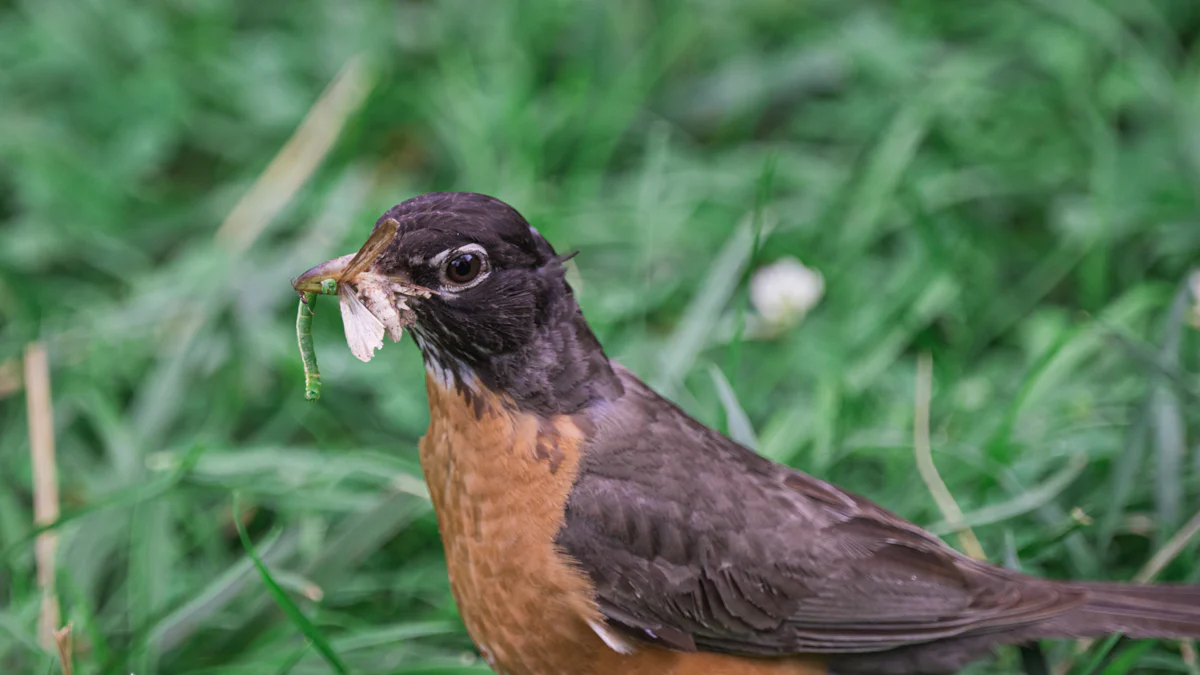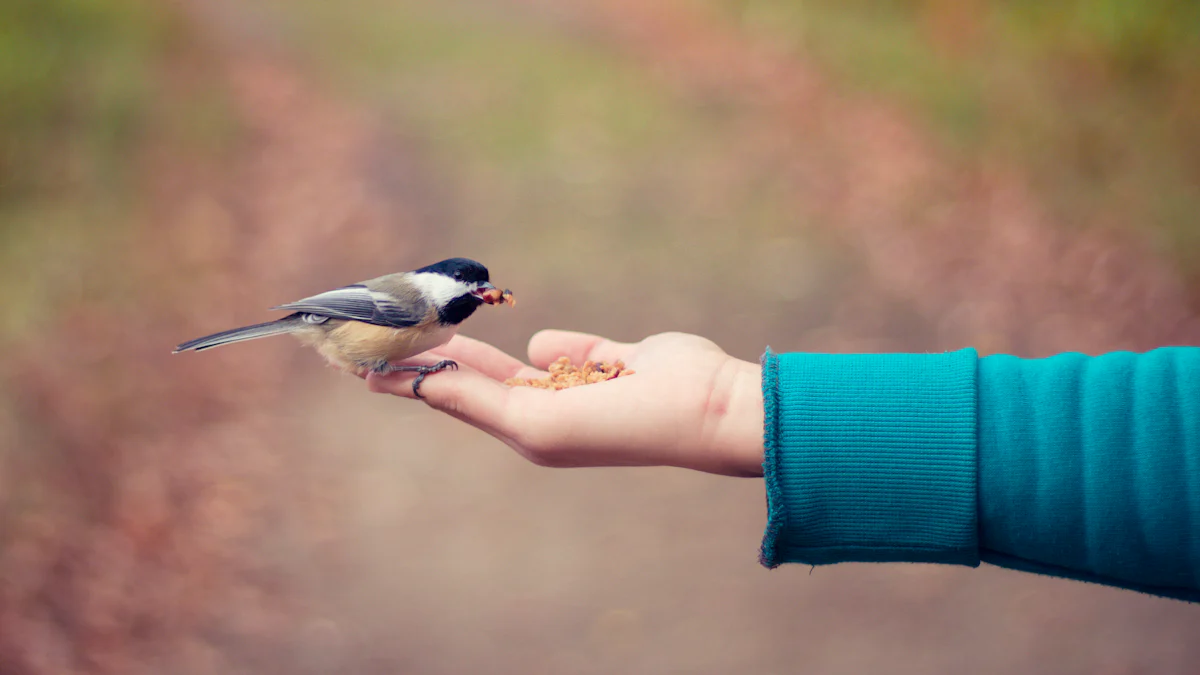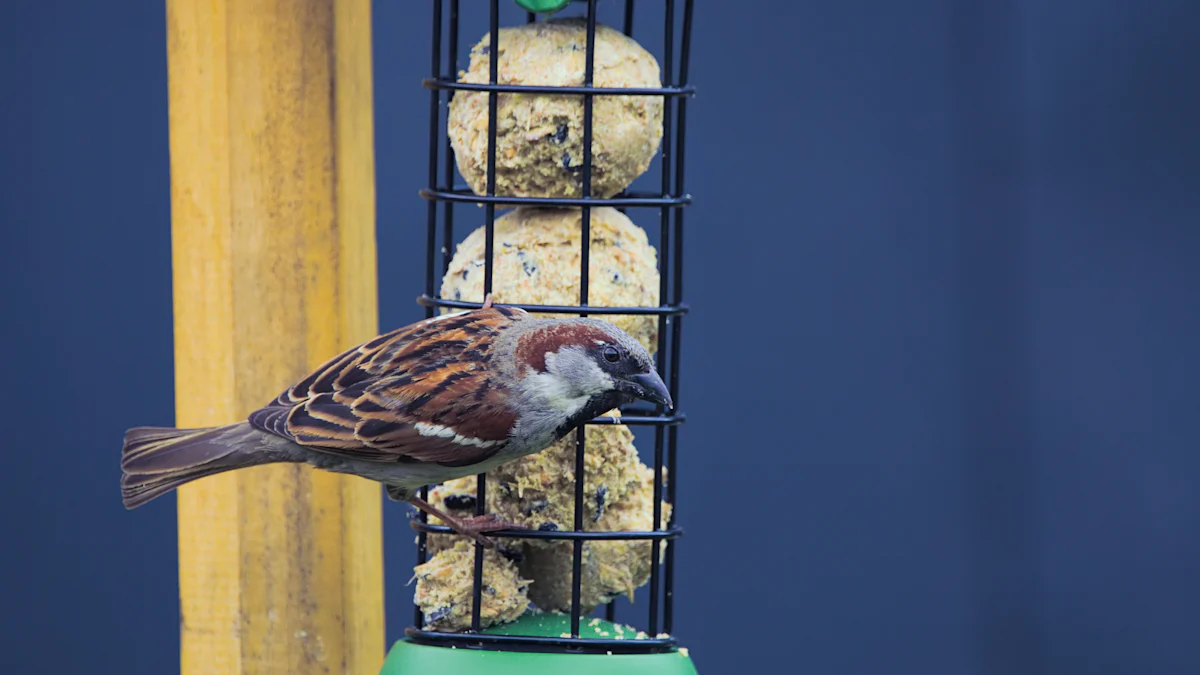
Feeding birds dried mealworms is an easy and rewarding way to support their health. These tiny treats are packed with nutrients like protein, fat, and essential vitamins, making them a powerhouse for energy and feather health. Simply place them in a feeder, scatter them on the ground, or mix them with other bird food. Birds love the taste, and their convenience makes them a favorite for bird enthusiasts. Whether it’s helping during molting or boosting energy in colder months, dried mealworms are a simple solution for bird lovers.
Key Takeaways
- Dried mealworms are a nutrient-rich food source for birds, providing essential protein and fat that support energy levels and feather health.
- These mealworms are convenient to use, requiring no refrigeration and having a long shelf life, making them ideal for busy bird enthusiasts.
- Feeding dried mealworms can help birds during critical times such as breeding, molting, and winter, ensuring they receive the nutrition they need year-round.
- You can serve dried mealworms in various ways: in feeders, scattered on the ground, or mixed with other bird foods to attract a wider range of species.
- Introduce dried mealworms gradually and in small amounts to help birds recognize them as food, and maintain a clean feeding area to prevent spoilage.
- Be patient and consistent in your feeding routine; it may take time for birds to adapt to new food sources, but regular offerings will encourage them to return.
- Avoid common mistakes like overfeeding or using spoiled mealworms, and pay attention to local bird preferences to create a successful feeding experience.
Benefits of Feeding Birds Dried Mealworms

Nutritional Value for Birds
Dried mealworms are a powerhouse of nutrition for birds. Packed with approximately 50% protein and 30% fat, they provide the essential nutrients birds need to thrive. Protein plays a vital role in supporting muscle development, feather health, and overall growth. Fat offers a quick energy boost, especially during colder months when birds require extra calories to stay warm. These tiny treats also contain oils and vitamins that help during breeding and molting seasons. By feeding birds dried mealworms, bird enthusiasts can ensure their feathered friends receive a balanced and energy-rich diet.
Convenience for Bird Enthusiasts
For bird lovers, dried mealworms offer unmatched convenience. Unlike live mealworms, they don’t require refrigeration or special care. They come ready to use and can be stored for long periods without spoiling. This makes them an excellent option for those who want to provide nutritious food without the hassle of maintaining live insects. Dried mealworms can also be easily mixed with other bird food, such as seeds or suet pellets, creating a versatile feeding option. Their ease of use allows bird enthusiasts to focus more on enjoying the birds rather than worrying about food preparation.
Seasonal Support for Birds
Different seasons bring unique challenges for birds, and dried mealworms can help them overcome these hurdles. During the breeding season, the high protein content supports egg-laying and the growth of fledglings. In colder months, the fat content provides much-needed energy to help birds survive harsh weather. Molting season can be stressful for birds, but the nutrients in dried mealworms promote healthy feather regrowth. By offering dried mealworms year-round, bird enthusiasts can support their local bird populations through every stage of their life cycle.
How to Prepare Dried Mealworms
Preparing dried mealworms for birds is simple and doesn’t take much time. Whether you use them dry or rehydrate them, both methods work well depending on the birds’ preferences and the season. Let’s explore the options and steps to get them ready.
Soaking vs. Using Them Dry
Dried mealworms can be fed to birds as they are or soaked in water to make them softer. Using them dry is the most convenient option. Birds like robins, blue tits, and sparrows often enjoy the crunchy texture. Dry mealworms are also easy to store and mix with other bird food like seeds or suet.
Soaking dried mealworms, however, can make them more appealing to some birds. Rehydrating them mimics the texture of live insects, which many insectivorous birds prefer. This method is especially helpful during hot weather or breeding seasons when birds need extra hydration. Soaked mealworms also provide a softer texture, making them easier for fledglings to eat.
Steps for Soaking Dried Mealworms
Rehydrating dried mealworms is quick and straightforward. Follow these steps to prepare them:
-
Measure the Mealworms
Decide how many mealworms you want to prepare. Start with a small amount if you’re introducing them to birds for the first time.
-
Use Warm Water
Place the dried mealworms in a bowl and pour warm water over them. The water should fully cover the mealworms.
-
Soak for 15–20 Minutes
Let the mealworms sit in the water for about 15–20 minutes. This allows them to absorb the water and regain a soft, plump texture.
-
Drain Excess Water
After soaking, drain the water using a strainer. Shake off any excess moisture to prevent the mealworms from becoming too soggy.
-
Serve Fresh
Offer the rehydrated mealworms immediately. Place them in a feeder, scatter them on the ground, or mix them with other bird food.
By soaking dried mealworms, bird enthusiasts can provide a more natural feeding experience. This small effort can make a big difference, especially for birds that rely on insects for their diet.
Best Ways to Offer Dried Mealworms

Dried mealworms are a versatile and nutritious treat for birds. Offering them in the right way can make all the difference in attracting a variety of feathered friends to your yard. Here are some of the best methods to serve dried mealworms.
Using Bird Feeders
Bird feeders provide a clean and convenient way to offer dried mealworms. Choose a feeder designed for mealworms or one with a shallow tray to prevent them from spilling. Place the feeder in a visible spot where birds feel safe. Hanging it near shrubs or trees gives birds a quick escape route from predators. Regularly check the feeder to ensure it stays clean and free of spoiled food.
Expert Tip from Uncle Jim’s Worm Farm: "You can place dried mealworms in their own feeder or mix them in with seed or suet."
Using a dedicated feeder for mealworms can help birds associate it with this specific treat. This method works well for species like bluebirds, robins, and wrens, which often visit feeders for insects.
Scattering Mealworms on the Ground
Scattering dried mealworms on the ground mimics the natural way birds forage for food. Ground-feeding birds like blackbirds, thrushes, and sparrows enjoy this method. Sprinkle a small amount in open areas or near bushes where birds feel secure. Avoid placing them too close to busy walkways or areas with heavy foot traffic.
This approach works especially well during the breeding season. Birds can quickly gather mealworms to feed their chicks. However, keep an eye out for pests like ants or rodents that may also be attracted to the food. Clean up any uneaten mealworms to maintain a healthy feeding environment.
Mixing Mealworms with Other Bird Food
Combining dried mealworms with other bird food creates a balanced and appealing mix. Add them to seeds, suet pellets, or even fruit pieces to attract a wider range of birds. This method is ideal for introducing mealworms to birds that may not recognize them as food at first.
Wiggly Wigglers highlights the benefits of dried mealworms, stating they are "highly nutritious and beneficial," making them an excellent addition to any bird food mix.
Mixing mealworms with other foods also helps stretch your supply, especially if you’re feeding a large number of birds. Start with a small amount and adjust based on how quickly the birds eat the mix. This ensures nothing goes to waste and keeps the feeding area tidy.
By using these methods, bird enthusiasts can make feeding birds dried mealworms simple and effective. Whether in a feeder, on the ground, or mixed with other foods, mealworms provide a nutritious boost that birds love.
Tips for Attracting Birds to Eat Dried Mealworms
Attracting birds to dried mealworms can take a little patience and strategy. Birds may not immediately recognize them as food, especially if they’re unfamiliar with mealworms. Here are some practical tips to help make your yard a favorite spot for feathered visitors.
Start with Small Quantities
Introducing dried mealworms in small amounts is a smart way to begin. Birds often need time to adjust to new food sources. By offering just a handful at first, you can gauge their interest without wasting food. This approach also prevents pests like ants or rodents from being drawn to large, uneaten portions.
One bird enthusiast shared their experience:
"I started with a small container of dried mealworms, but my local birds didn’t seem interested at first. Over time, I noticed bluebirds and wrens began to visit more frequently. Now, they’re regulars at my feeders!"
If the birds in your area are hesitant, try mixing the mealworms with their usual food. This can help them associate the new treat with something familiar.
Choose Safe and Quiet Locations
Birds feel most comfortable eating in areas where they sense safety. Place the mealworms in spots that are quiet and away from heavy foot traffic. Shrubs, trees, or other natural cover nearby can provide a sense of security. Birds like bluebirds, wrens, and robins are more likely to visit feeders or ground-scattered mealworms when they feel protected from predators.
Avoid placing mealworms too close to busy walkways or loud areas. A calm environment encourages birds to explore and return regularly. If you’re unsure where to start, observe where birds naturally gather in your yard and set up feeding stations there.
Use Other Foods to Attract Birds
Combining dried mealworms with other bird favorites can increase their appeal. Seeds, suet, or fruit pieces work well as a mix. Birds that are unfamiliar with mealworms may be drawn in by the other foods and eventually try the mealworms too.
Pro Tip: "Mixing mealworms with seeds or suet not only attracts a variety of birds but also stretches your supply of mealworms, making it a cost-effective option."
Some bird species, like sparrows or cardinals, might initially ignore dried mealworms. However, mixing them with their preferred food can gradually introduce them to this nutritious treat. Over time, even hesitant birds may develop a taste for mealworms.
By starting small, choosing safe locations, and using other foods as bait, bird enthusiasts can make feeding birds dried mealworms a rewarding experience. Patience and consistency are key. Once birds recognize mealworms as a reliable food source, they’ll keep coming back for more.
Be Patient and Consistent
Birds may not immediately recognize dried mealworms as food, especially if they are unfamiliar with them. Patience and consistency play a crucial role in helping birds adapt to this new treat. Regularly offering mealworms in the same location can encourage birds to explore and eventually accept them.
Start by observing the birds in your area. Some species, like bluebirds and wrens, are more likely to try dried mealworms, while others may take longer to show interest. One bird enthusiast shared their experience of feeding dried mealworms to nesting bluebirds, noting how the birds used them to feed their young while also catching live insects. This combination of food sources helped the young birds grow strong and healthy. Over time, the bluebirds became regular visitors, returning for more mealworms.
For those who don’t see immediate success, it’s important to stay consistent. Birds often need time to trust a new food source. Place mealworms in feeders or scatter them in areas where birds naturally gather. Avoid moving the feeding station frequently, as this can confuse the birds. Instead, keep the setup stable and predictable.
“I tried offering dried mealworms in my backyard feeders, but the local birds ignored them at first,” shared another bird lover. “After a few weeks of consistently placing them in the same spot, I noticed bluebirds and wrens starting to visit. Now, they’re regulars!”
If birds still seem hesitant, try mixing mealworms with other familiar foods like seeds or suet. This can help them associate the mealworms with something they already enjoy. Gradually reduce the amount of mixed food as they become accustomed to the mealworms.
Consistency also means maintaining a clean and safe feeding environment. Remove uneaten mealworms daily to prevent spoilage or pests. Birds are more likely to return to a feeding area that feels fresh and inviting.
Patience truly pays off when feeding birds dried mealworms. By staying consistent and giving birds time to adjust, bird enthusiasts can create a reliable feeding routine that attracts a variety of feathered friends. Watching birds return again and again is a rewarding experience that makes the effort worthwhile.
Common Mistakes to Avoid When Feeding Birds Dried Mealworms
Overfeeding Birds
Overfeeding birds with dried mealworms can lead to unintended consequences. While mealworms are nutritious, they should not replace a bird’s natural diet. Birds need a variety of foods, including seeds, fruits, and insects, to stay healthy. Offering too many mealworms might cause birds to rely solely on them, which could result in nutritional imbalances.
To avoid overfeeding, start with small portions. Observe how much the birds consume in a day and adjust accordingly. A handful of mealworms is usually enough for most backyard birds. Regularly monitor the feeding area to ensure no excess food is left behind. Leftover mealworms can attract pests like ants or rodents, creating additional problems.
Tip from Vine House Farm: "Dried mealworms are convenient and beneficial, but they should complement a bird’s diet, not dominate it."
By offering mealworms in moderation, bird enthusiasts can support their feathered friends without disrupting their natural eating habits.
Using Spoiled Mealworms
Spoiled mealworms pose a risk to birds’ health. Dried mealworms, although easy to store, can go bad if exposed to moisture or left out for too long. Moldy or spoiled mealworms may cause illness in birds, making it essential to check their quality before serving.
Store dried mealworms in a cool, dry place to keep them fresh. Airtight containers work well to prevent moisture from seeping in. When feeding, only put out as much as the birds will eat in a day. Discard any uneaten mealworms at the end of the day to maintain a clean feeding area.
One bird enthusiast shared:
"I noticed birds stopped visiting my feeder. When I checked, the mealworms had become damp and moldy. After switching to fresh ones, the birds returned quickly."
Keeping mealworms fresh ensures birds receive safe and nutritious food. Regularly inspecting the mealworms for signs of spoilage can prevent potential health issues.
Ignoring Local Bird Preferences
Not all birds enjoy dried mealworms. Some species may prefer seeds, fruits, or live insects. Ignoring the preferences of local birds can result in wasted food and fewer visitors to your yard. Understanding the habits and diets of the birds in your area is key to successful feeding.
Start by observing the birds that frequent your yard. Bluebirds, robins, and wrens are known to enjoy dried mealworms. If these species are common in your area, mealworms can be a great addition to your feeders. For birds unfamiliar with mealworms, try moistening them slightly to make them more appealing. This mimics the texture of live insects, which many birds find irresistible.
Advice from Uncle Jim’s Worm Farm: "Moistening dried mealworms can tempt birds to try them, especially if they’re new to this food source."
Combining mealworms with other bird foods, like seeds or suet, can also attract a wider variety of species. This approach helps birds recognize mealworms as a food source while catering to their individual tastes.
By avoiding these common mistakes, bird enthusiasts can create a safe and welcoming environment for their feathered visitors. Paying attention to portion sizes, food quality, and local bird preferences ensures a rewarding bird-feeding experience for both birds and humans alike.
Feeding birds dried mealworms offers a simple way to support their health while enjoying the beauty of nature in your yard. These nutrient-packed treats provide energy and promote feather growth, making them a valuable addition to any bird feeding routine. However, moderation is key. Overfeeding dried mealworms can lead to dehydration or digestive issues, especially for nestlings. Start small, observe the birds’ preferences, and maintain a clean feeding area. Consistency and care will attract a variety of birds, creating a rewarding experience for both you and your feathered visitors.
FAQ
What are dried mealworms, and why are they good for birds?
Dried mealworms are the dehydrated form of live mealworms, which are the larvae of darkling beetles. They are packed with protein, fat, and essential vitamins, making them a highly nutritious food source for birds. These nutrients help birds maintain energy, grow healthy feathers, and thrive during challenging seasons like winter or molting.
Can all birds eat dried mealworms?
Most insect-eating birds enjoy dried mealworms. Species like bluebirds, robins, wrens, and chickadees are particularly fond of them. Ground-feeding birds, such as blackbirds and thrushes, also love foraging for mealworms. However, some seed-eating birds may take time to recognize mealworms as food.
Are dried mealworms better than live mealworms?
Both dried and live mealworms have their benefits. Dried mealworms are convenient to store and easy to use, making them ideal for everyday feeding. Live mealworms, on the other hand, provide more hydration and are especially beneficial during breeding seasons when birds need extra moisture and energy. For a balanced approach, bird enthusiasts can offer both types depending on the season and bird preferences.
How should dried mealworms be stored?
Store dried mealworms in a cool, dry place to keep them fresh. Airtight containers work best to prevent moisture from spoiling them. Avoid exposing them to direct sunlight or humidity, as this can lead to mold or spoilage. Proper storage ensures the mealworms remain safe and nutritious for birds.
Should dried mealworms be soaked before feeding?
Soaking dried mealworms is optional but can make them more appealing to some birds. Rehydrating them softens their texture, mimicking live insects. This is especially helpful during hot weather or for fledglings that may struggle with dry food. To soak, simply cover the mealworms with warm water for 15–20 minutes, then drain and serve.
How often should dried mealworms be offered?
Dried mealworms should be offered in moderation as part of a varied diet. Birds need a mix of seeds, fruits, and insects to stay healthy. A handful of mealworms per day is usually enough for most backyard birds. Overfeeding can lead to nutritional imbalances or attract pests, so it’s best to monitor how much the birds consume.
Can dried mealworms attract pests?
Yes, if left uneaten, dried mealworms can attract ants, rodents, or other pests. To avoid this, only put out as much as the birds will eat in a day. Clean up any leftovers daily and store mealworms in sealed containers to keep pests away.
Do dried mealworms help birds during winter?
Absolutely! Dried mealworms are high in fat and protein, providing birds with the energy they need to stay warm during cold months. They are an excellent supplement to seeds and suet, helping birds survive harsh winter conditions. Offering mealworms in winter can also attract a variety of bird species to your yard.
Can baby birds eat dried mealworms?
Dried mealworms can be safe for baby birds if offered in moderation and soaked beforehand. Soaking softens the mealworms, making them easier for nestlings to digest. However, adult birds naturally balance their chicks’ diet by combining mealworms with other food sources like seeds and live insects.
Can dried mealworms replace a bird’s natural diet?
No, dried mealworms should not replace a bird’s natural diet. Birds require a variety of foods, including seeds, fruits, and live insects, to meet their nutritional needs. Mealworms are a great supplement but should be part of a balanced feeding routine. Providing diverse food options ensures birds stay healthy and thrive.


